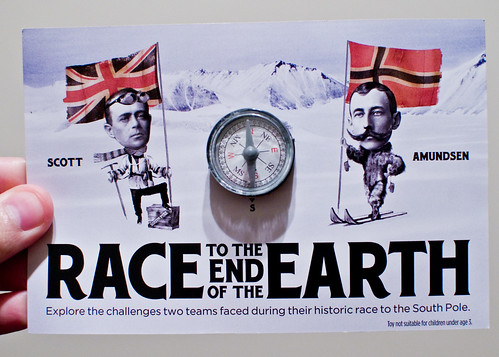
‘National Geographic – Race Preview – 05-24-11 01’
courtesy of ‘mosley.brian’
What would you do, what would you go through, to be the first explorers to the South Pole? Would you go through months of trekking through -40F degree cold, on a strict ration of food, constantly freezing and wet, and risking death every day? If that sounds like a great time, the National Geographic has the exhibit for you!
To celebrate the 100th anniversary of the first men to reach the South Pole, the National Geographic Museum is hosting an exhibition entitled Race to the End of the Earth. It recounts the challenges of two explorers during their race to reach the South Pole. On a 1,800-mile journey through Antarctica in 1911, explorers Roald Amundsen of Norway and Robert Falcon Scott of Britain fought the elements and raced each other to gain the honor. The exhibit is well suited for the National Geographic, because it adds the adventure and exploration elements to a fascinating and not well known historical story.
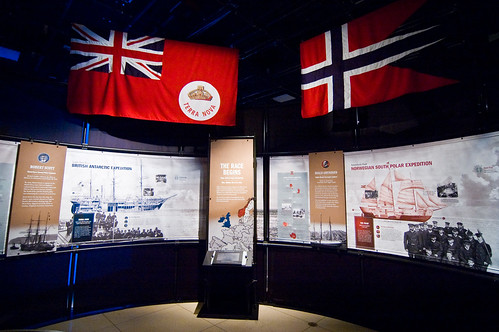
‘National Geographic – Race Preview – 05-24-11 13’
courtesy of ‘mosley.brian’
Before we go any further, let me just say, and I can’t believe I’m doing this for a 100 year old historical event, but there will be **SPOILERS** from here on out. I will say who won and what happened to people involved. Don’t blame me, or your history books, or Wikipedia, for giving away the ending. You’ve had 100 years to find this information out.
The exhibit starts off with visitors getting a chance to pick up cards which have information on specific members of the two expeditions. The idea is to follow that person through the expedition and see how things turn out. It certainly creates a personal connection to these men. I ended up getting a card for each team, and the two men’s journeys couldn’t have been more different. The Norwegian, Oscar Wisting, 39 at the time of the expedition and veteran of the Norwegian Navy, got to the South Pole with his team and got home in one piece. Henry “Birdie” Bowers, the Brittan, 27 and a “Jack-of-all-trades,” reached the South Pole a month after the Norwegians, but never made it off the Ross Ice Shelf alive. At the end of the exhibit, in a very touching and emotional display, you get a chance to read Bowers’ final letter to his mother, which he wrote during the failed return from the Pole, fully knowing he wouldn’t make it.
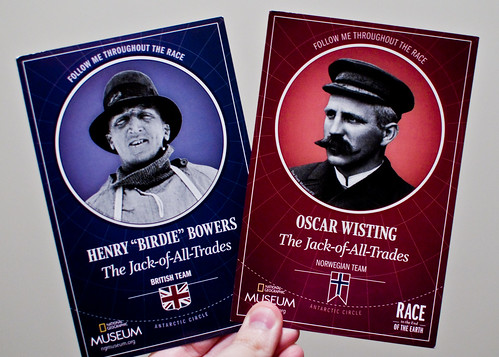
‘National Geographic – Race Preview – 05-24-11 02’
courtesy of ‘mosley.brian’
Visitors are taken through both expeditions, from preparation through the trek to the Pole and the return trips on the ice shelf. Through a multitude of of displays, visitors get a good idea of what the trip was like. There are recreations of the base camp shelters that both the British and Norwegians used; rare historical artifacts used by the participants in the expeditions; and even dioramas which do a fantastic job of giving the visitors an idea of what the two teams were coping with, such as white out.

‘National Geographic – Race Preview – 05-24-11 11’
courtesy of ‘mosley.brian’
Mid-way through the exhibit you come to the Norwegian’s triumph of reaching the South Pole, 35 days ahead of the British. The exhibition actually recreates the Norwegian’s camp, Polheim, and has a fascinating recording of Amundsen speaking about the accomplishment. When you realize you are only half way through the exhibit, you suddenly remember that these men are not done. The trip back home is as dangerous as the trip to the Pole.
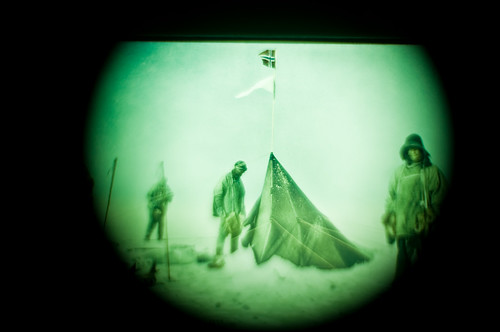
‘National Geographic – Race Preview – 05-24-11 12’
courtesy of ‘mosley.brian’
The exhibition continues with the doomed return of the British team. It was simply an issue of weather: the British took too long to get to the South Pole and got stuck in cold and nasty weather returning to their base camp. In the end the four-man British team, which had reached the Pole, perished on the ice shelf. In contrast, the Norwegians didn’t lose a single man or even a sled dog! The British team knew they were done for, and wrote the last thoughts to their loved ones in their journals. Those pages are the last part of the exhibit and they create a very sad and emotional ending.
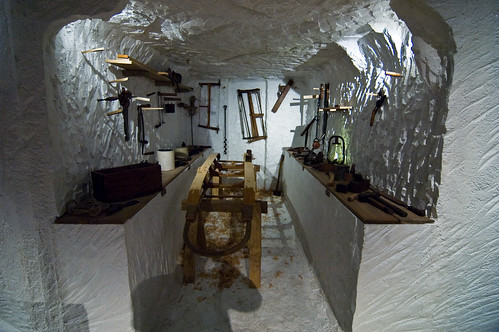
‘National Geographic – Race Preview – 05-24-11 10’
courtesy of ‘mosley.brian’
The exhibit finishes with a brief explanation of what is going on Antarctica today. To sum it up: Science, gobs and gobs of science! From geology to astrophysics. Or, if you like, as only xkcd can say it.
The Race to the End of the Earth does require tickets for entry. Admission is $8 for adults; $6 for National Geographic members, military, students, seniors, and groups of 25 or more; and $4 for children 5-12 (free for 4 and under). The exhibit runs from May 25th to August 21, 2011.
The National Geographic Museum is located at 1145 17th Street NW; tickets can be purchased online or by phone (202-857-7588).

